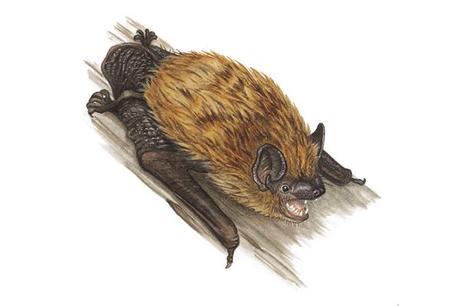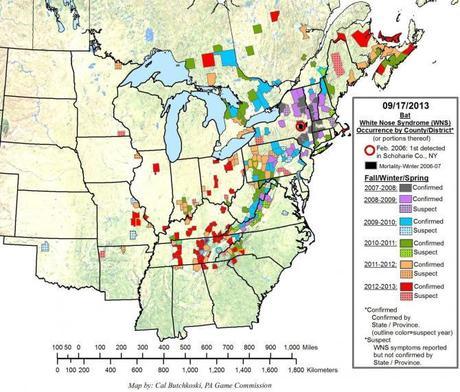Arizona Bat Peril Increases

Big Brown Bat from Smithsonian North American Mammals
The most important change since my last post about Arizona bats is the increased risk of white-nose syndrome. The disease continues to spread west from its point of introduction on the U. S. Atlantic coast despite research and quarantine efforts. In September, 2013, researchers confirmed the disease had reached Oklahoma and South Dakota (http://whitenosesyndrome.org/resources/map).
The entities that gain most from
bat extinction are insecticide producers.

Arizona Bat Numbers
According to the October 10 report by the Arizona Game and Fish Department (AZGFD), there are 33 Arizona species. All but two are of concern or of possible long-term concern. One, the Lesser Long-nosed Bat, is on the ESA endangered species list.
- World: 1200+
- United States: 45
- Arizona: 33
- Arizona bat species of concern: 31 (94%)
- ESA Arizona bats listed endangered: 1 (and one partial)
- ESA Arizona bats of concern: 15
Arizona Bat References
- Naturalist’s Bookstore has field guides (at the end of the category list) and other references.
- American Society of Mammalogists: http://www.mammalsociety.org.
- Arizona Bat Resource Group. Facebook Page: http://on.fb.me/150L4FQ.
- Arizona Game and Fish Department (AZGFD). List of “nongame” species includes bats: http://bit.ly/YOa6og. AZGFD has a bat conservation plan, but the plan needs to be updated.
- Hinman, K.E., and T.K. Snow. 2003. Arizona Bat Conservation Strategic Plan. Nongame Branch, Wildlife Management Division, Region 5, Field Operations Division, Arizona Game and Fish Department. 173 p. (Available online at: http://bit.ly/ZjDvTV).
- Bats. Kunz Bat Lab: http://www.bu.edu/cecb/BATS/.
- Bat Conservation International: http://www.batcon.org/.
- Carson, R. 1962. Silent spring. Houghton Mifflin, New York. 400 p.
- Genoways, T. August 30, 2011. The Man Who Loved Bats. On Earth News.
- Hoffa, R.L., and W. Anderson. 1996. Coexisting with urban wildlife: A guide to the central Arizona uplands. Sharlot Hall Museum Press, Prescott, AZ. 123 p.
- Kays, R.W., and D.E. Wilson. 2009. Mammals of North America (second edition). Princeton University Press, Princeton, NJ. 248 p.
- National Wildlife Federation: www.nwf.org.
- Organization for Bat Conservation: http://www.batconservation.org.
- Pesticide Action Network, North America: http://www.panna.org.
- Smithsonian: http://www.mnh.si.edu/mna. Mammal conservation status: http://www.mnh.si.edu/mna/search_latlong.cfm.
- Tuttle, M.D., and D. L. Hensley. 2000. The bat house builder’s handbook. Bat Conservation International, Austin, TX. 36 p.
- U. S. Fish and Wildlife Service: http://www.fws.gov.
- U. S. Forest Service. 2007. Regional Forester’s list of sensitive animals: http://www.fs.usda.gov/Internet/FSE_DOCUMENTS/fsbdev3_021328.pdf.
- Western Bat Working Group: http://www.wbwg.org.
- WhiteNoseSyndrome.org.
- World Conservation Union: www.iucn.org.
Conservation Status Symbol Definitions (from AZGFD)
Symbols used by Arizona Game and Fish Department (AZGFD). I added question marks to two undefined symbols.
- S1 Critically Imperiled: Extremely rare or some factor(s) is making the species especially vulnerable to extirpation. Typically 5 or fewer locations or very few remaining individuals (<1,000).
- S2 Imperiled: Rare or some factor(s) is making the species very vulnerable to extirpation. Typically 6 to 20 occurrences or few remaining individuals (1,000 to 3,000).
- S3 Vulnerable: Rare or found only in a restricted range (even if abundant at some locations), or because of other factors making it vulnerable to extirpation. Typically 21 to 100 occurrences or between 3,000 and 10,000 individuals.
- S4 Apparently Secure: Uncommon but not rare, and usually widespread. Usually more than 100 occurrences* and more than 10,000 individuals. Possible long-term concern.
- S5 Secure: Common, widespread, and abundant. Safe under present conditions. Typically with considerably more than 100 locations and more than 10,000 individuals.
- S#S#: Indicates the range of uncertainty about exact status (e.g., S3S4).
- E: Exotic Origin: Species is not native to AZ.
Symbols Used for the Endangered Species Act (ESA)
(US Department of Interior, Fish and Wildlife Service)
- LE Listed Endangered: Imminent jeopardy of extinction.
- PS Partial Status: Listed Endangered or Threatened, but not in entire range.
- No (No Status) Certain populations of this taxon do not have designated status (check with state or regional USFWS office for details about which populations have designated status).
- PE Proposed Endangered
- SC Species of Concern: Describes the entire realm of taxa whose conservation status may be of concern to the US Fish and Wildlife Service, but does not have official federal status.
A R I Z O N A B A T S
SCIENTIFIC NAME
COMMON NAME
AZ
ESA
Antrozous pallidus
Pallid Bat
S4
Choeronycteris mexicana
Mexican Long-tongued Bat
S3
SC
Corynorhinus townsendii
Townsend’s Big-eared Bat
S3S4
No
Corynorhinus townsendii pallescens
Pale Townsend’s Big-eared Bat
S3S4
SC
Enchisthenes hartii
Velvety Fruit-eating Bat
SA?
Eptesicus fuscus
Big Brown Bat
S4S5
Euderma maculatum
Spotted Bat
S2S3
SC
Eumops perotis
Western Bonneted Bat
S3
Eumops perotis californicus
Greater Western Bonneted Bat
S3
SC
Eumops underwoodi
Underwood’s Bonneted Bat
S1
SC
Idionycteris phyllotis
Allen’s Lappet-browed Bat
S2S3
SC
Lasionycteris noctivagans
Silver-haired Bat
S3S4
Lasiurus blossevillii
Western Red Bat
S3
Lasiurus cinereus
Hoary Bat
S4
No
Lasiurus xanthinus
Western Yellow Bat
S2S3
Leptonycteris curasoae
Southern Long-nosed Bat
S2
PS
Leptonycteris curasoae yerbabuenae
Lesser Long-nosed Bat
S2S3
LE
Leptonycteris nivalis
Mexican Long-nosed Bat
SP?
Macrotus californicus
California Leaf-nosed Bat
S3
SC
Mormoops megalophylla
Ghost-faced Bat
SA?
Myotis auriculus
Southwestern Myotis
S3
Myotis californicus
California Myotis
S4
Myotis ciliolabrum
Western Small-footed Myotis
S3S4
SC
Myotis evotis
Long-eared Myotis
S3
SC
Myotis occultus
Arizona Myotis
S3
SC
Myotis thysanodes
Fringed Myotis
S3S4
SC
Myotis velifer
Cave Myotis
S3S4
SC
Myotis volans
Long-legged Myotis
S3S4
SC
Myotis yumanensis
Yuma Myotis
S3S4
SC
Nyctinomops femorosaccus
Pocketed Free-tailed Bat
S3
Nyctinomops macrotis
Big Free-tailed Bat
S3
SC
Parastrellus hesperus
Canyon Bat
S5
Tadarida brasiliensis
Brazilian Free-tailed Bat
S3S4
Google+


